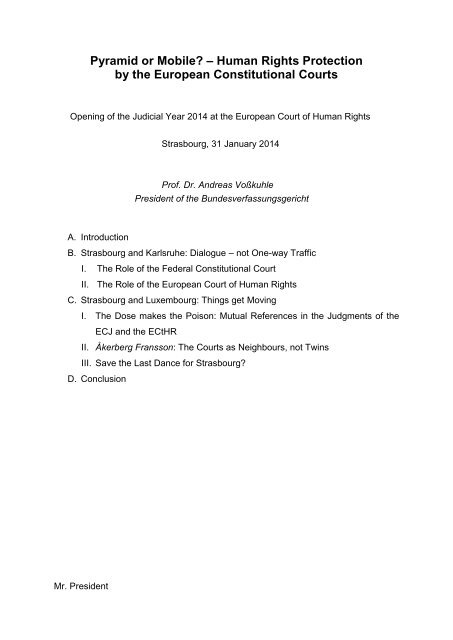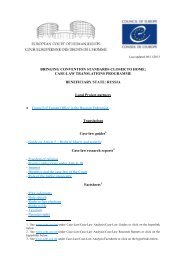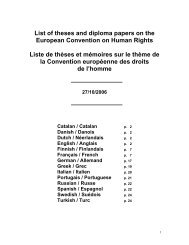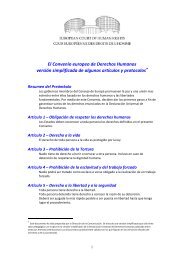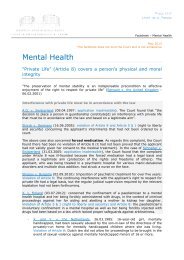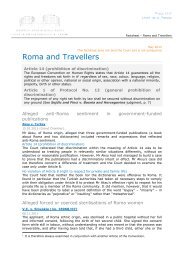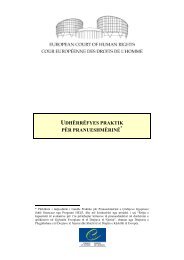Speech by Andreas Voßkuhle - European Court of Human Rights
Speech by Andreas Voßkuhle - European Court of Human Rights
Speech by Andreas Voßkuhle - European Court of Human Rights
You also want an ePaper? Increase the reach of your titles
YUMPU automatically turns print PDFs into web optimized ePapers that Google loves.
Pyramid or Mobile? – <strong>Human</strong> <strong>Rights</strong> Protection<br />
<strong>by</strong> the <strong>European</strong> Constitutional <strong>Court</strong>s<br />
Opening <strong>of</strong> the Judicial Year 2014 at the <strong>European</strong> <strong>Court</strong> <strong>of</strong> <strong>Human</strong> <strong>Rights</strong><br />
Strasbourg, 31 January 2014<br />
Pr<strong>of</strong>. Dr. <strong>Andreas</strong> <strong>Voßkuhle</strong><br />
President <strong>of</strong> the Bundesverfassungsgericht<br />
A. Introduction<br />
B. Strasbourg and Karlsruhe: Dialogue – not One-way Traffic<br />
I. The Role <strong>of</strong> the Federal Constitutional <strong>Court</strong><br />
II. The Role <strong>of</strong> the <strong>European</strong> <strong>Court</strong> <strong>of</strong> <strong>Human</strong> <strong>Rights</strong><br />
C. Strasbourg and Luxembourg: Things get Moving<br />
I. The Dose makes the Poison: Mutual References in the Judgments <strong>of</strong> the<br />
ECJ and the ECtHR<br />
II. Åkerberg Fransson: The <strong>Court</strong>s as Neighbours, not Twins<br />
III. Save the Last Dance for Strasbourg?<br />
D. Conclusion<br />
Mr. President
- 2 -<br />
Dear colleagues<br />
Ladies and Gentlemen,<br />
it is a true Honour for me to join you today for the opening <strong>of</strong> the judicial year, and I<br />
thank you very much for the invitation to take part in this important occasion.<br />
A. Introduction<br />
The title <strong>of</strong> my speech is “Pyramid or Mobile? – <strong>Human</strong> <strong>Rights</strong> Protection <strong>by</strong> the<br />
<strong>European</strong> Constitutional <strong>Court</strong>s”. Contrary to what “pyramid or mobile” might suggest,<br />
I am not going to talk about telecommunications in Egypt. By “mobile”, I mean – inspired<br />
<strong>by</strong> the former judge Renate Jaeger – a kinetic sculpture which consists <strong>of</strong> an<br />
ensemble <strong>of</strong> balanced parts that can move but is connected through strings or wire. 1<br />
When I use the word “pyramid”, I refer to a fixed geometric structure that has a base<br />
and a top.<br />
In the following, I will try to establish which <strong>of</strong> these two images is more suitable<br />
to capture characteristics <strong>of</strong> the <strong>European</strong> constitutional courts in their protection <strong>of</strong><br />
human rights. In order to do this, we need to examine some features <strong>of</strong> the interaction<br />
<strong>of</strong> these courts and <strong>of</strong> their respective catalogues <strong>of</strong> rights. The system <strong>of</strong> human<br />
rights protection in Europe is a topic which I already highlighted in past speeches.<br />
However, we will see that the “Verbund” is a living and changing organism that deserves<br />
to be observed, accompanied and re-balanced in its constant evolution. In the<br />
following, I will approach this very complex topic <strong>by</strong> making just a few brief observations.<br />
B. Strasbourg and Karlsruhe: Dialogue –<br />
not One-way Traffic<br />
Ladies and Gentlemen,
- 3 -<br />
If you look at the parts <strong>of</strong> a mobile for some time, you will realise that they are not<br />
revolving around their own axes, but are constantly engaging in an imaginary dialogue,<br />
induced <strong>by</strong> the movements <strong>of</strong> the other parts. The ECtHR and the FCC <strong>of</strong><br />
Germany – like all national constitutional courts – also depend on a permanent dialogue,<br />
in order to coordinate the protection <strong>of</strong> fundamental rights in a multilevel system.<br />
How does the interplay <strong>of</strong> the <strong>European</strong> Convention on <strong>Human</strong> <strong>Rights</strong> and the<br />
German Constitution work? Which concessions do the ECtHR and the FCC have to<br />
make in order to coordinate their work? Where might corrections be necessary?<br />
To ease the suspense: A strictly hierarchical – in other words: pyramidal – approach<br />
would not fit the characteristics <strong>of</strong> a “Verbund” <strong>of</strong> <strong>European</strong> Constitutional<br />
<strong>Court</strong>s.<br />
I. The Role <strong>of</strong> the Federal Constitutional <strong>Court</strong><br />
First <strong>of</strong> all, let us examine the “mobile <strong>of</strong> institutions” from the point <strong>of</strong> view <strong>of</strong> the<br />
FCC. The Basic Law is not only open towards <strong>European</strong> and international law, it is<br />
also specifically open towards human rights. The Basic Law places the FCC, as well<br />
as all other constitutional bodies, at the service <strong>of</strong> international human rights. Our<br />
recent case law shows that these words do not merely represent constitutional poetry.<br />
In May 2011, subsequent to your decision in M. v. Germany <strong>of</strong> December 2009, 2<br />
the FCC delivered a judgment concerning preventive detention in Germany 3 . Two<br />
aspects <strong>of</strong> this judgment prove the FCC´s openness towards human rights. First, the<br />
FCC chose to apply national procedural rules flexibly to avoid another breach <strong>of</strong> the<br />
Convention. Despite a former decision declaring the provisions on preventive detention<br />
constitutional, which, under German law, generally constitutes a procedural bar<br />
against the admissibility <strong>of</strong> new proceedings, the FCC considered the new constitutional<br />
complaints admissible with regard to the decision in M. v. Germany. 4 And secondly,<br />
the FCC stressed that the Convention has to be thoroughly considered at an<br />
early stage in the context <strong>of</strong> the receiving constitutional system. Although in Germany,<br />
the <strong>European</strong> Convention on <strong>Human</strong> <strong>Rights</strong> does not have the same rank as the
- 4 -<br />
Constitution, it does have significance under our constitutional law. For the FCC, it is<br />
an important guide to interpretation in determining the content and scope <strong>of</strong> fundamental<br />
rights and constitutional guarantees <strong>of</strong> the Basic Law.<br />
As you can see, the FCC accepts impulses from Strasbourg and is able to remedy<br />
breaches <strong>of</strong> the Convention already on a national level – there<strong>by</strong> providing relief<br />
to the caseload <strong>of</strong> the ECtHR. We are pleased that in the Kronfeldner case, 5 the ECtHR<br />
recently welcomed our approach <strong>of</strong> interpreting the Basic Law in in the light <strong>of</strong><br />
the Convention, as this manifests the intensive dialogue between the two courts.<br />
However, acceptance <strong>of</strong> the Convention should not be mistaken for strict obedience.<br />
The Basic Law has certain limits when it comes to its interpretation with regard<br />
to international law. The comparative interpretation has to be methodically justifiable<br />
and compatible with the Basic Law’s core values (Art. 79 sec. 3 GG). 6 In addition, the<br />
interpretation must not ‘– according to Art. 53 <strong>of</strong> the Convention – compromise the<br />
standard <strong>of</strong> protection <strong>of</strong> fundamental rights provided <strong>by</strong> the Basic Law. 7 Occasionally,<br />
the Basic Law guarantees a higher level <strong>of</strong> protection. This is illustrated <strong>by</strong> two<br />
recent cases, one <strong>by</strong> the ECtHR, the other <strong>by</strong> the FCC, that were delivered on the<br />
same day. The ECtHR´s judgment in X and others v. Austria <strong>of</strong> 19 February 2013<br />
concerned the right <strong>of</strong> unmarried same-sex couples to second-parent adoption, 8<br />
while the FCC´s judgment concerned the non-admission <strong>of</strong> successive adoption <strong>by</strong><br />
registered civil (same-sex) partners 9 . Whereas the ECtHR held that there had been<br />
no violation <strong>of</strong> Art. 14 in conjunction with Art. 8 <strong>of</strong> the Convention when the applicants’<br />
situation was compared with that <strong>of</strong> a married couple 10 , the FCC found that the<br />
exclusion <strong>of</strong> successive adoption <strong>by</strong> registered civil partners violated the general<br />
principle <strong>of</strong> equality before the law (Art. 3 sec. 1 GG) 11 .<br />
II.<br />
The Role <strong>of</strong> the <strong>European</strong> <strong>Court</strong> <strong>of</strong> <strong>Human</strong> <strong>Rights</strong><br />
And what does the basis <strong>of</strong> a cooperation on the part <strong>of</strong> the <strong>European</strong> <strong>Court</strong> <strong>of</strong><br />
<strong>Human</strong> <strong>Rights</strong> look like? My opinion is: The <strong>European</strong> <strong>Court</strong> <strong>of</strong> <strong>Human</strong> <strong>Rights</strong> is not a<br />
lonesome fighter either, but a strong player in a team. It does not render national<br />
constitutional courts unnecessary, but takes their existence as a precondition. To
- 5 -<br />
keep to my picture <strong>of</strong> the mobile <strong>of</strong> institutions: Each element is necessary to keep<br />
the balance. Otherwise one lonesome pendulum would orbit around itself.<br />
In order to perform this balancing act, the ECtHR is, as an international court,<br />
confronted with the task <strong>of</strong> defining the minimum standard <strong>of</strong> fundamental rights protection.<br />
This minimum standard can be accepted <strong>by</strong> national authorities and courts <strong>of</strong><br />
all Member States, without giving up the plurality <strong>of</strong> national fundamental rights provisions.<br />
At the same time, when it comes to the effective enforcement and the dynamic<br />
development <strong>of</strong> the Convention, the ECtHR increases its acceptance <strong>by</strong> being considerate<br />
in its handling <strong>of</strong> the national “inheritance” – traditions that have evolved<br />
over a long time. The Grand Chamber judgment <strong>of</strong> Lautsi and Others v. Italy <strong>of</strong> 18<br />
March 2011 is a fine example <strong>of</strong> judicial self-restraint. In the judgment, the Chamber<br />
stated that the decision whether crucifixes should be present in classrooms was a<br />
matter falling within the margin <strong>of</strong> appreciation <strong>of</strong> the respective State party. Thus, it<br />
took into account the statements <strong>of</strong> the Italian government, which had put forward<br />
that the presence <strong>of</strong> crucifixes in classrooms had not only cultural significance but<br />
also an identity-creating effect. 12 Furthermore, the ECtHR fortunately respects the<br />
margin <strong>of</strong> appreciation where a case raises sensitive moral or ethical issues, on<br />
which no consensus has been reached between the Member States. In this regard,<br />
one example is the case <strong>of</strong> Stuebing, in which the ECtHR held that the applicant’s<br />
conviction <strong>by</strong> German courts for an incestuous relationship did not violate Art. 8 <strong>of</strong><br />
the Convention. And not to forget the Countryside Alliance case, in which the ECtHR<br />
decided that the various bans on fox hunting and the hunting <strong>of</strong> other wild mammals<br />
with dogs in the United Kingdom did not amount to a violation <strong>of</strong> the Convention. 13<br />
Even Lord Bingham´s, well, very British argument to justify the ban, namely the suggestion,<br />
I quote, “that the British mind more about their animals than their children” 14 ,<br />
was apparently regarded as falling within the margin <strong>of</strong> appreciation. 15<br />
As you know, the Council <strong>of</strong> Europe has, in the meantime, submitted the Protocol<br />
No. 15 to the Convention, which incorporates into the preamble a reference to the<br />
principle <strong>of</strong> subsidiarity and the doctrine <strong>of</strong> the margin <strong>of</strong> appreciation. 16 This is a major<br />
contribution to the rebalancing <strong>of</strong> our mobile <strong>of</strong> institutions. The more the implementation<br />
<strong>of</strong> the Convention is deferred to the national authorities and courts, the<br />
better can the ECtHR – in light <strong>of</strong> its limited resources – focus on its role as the<br />
guardian <strong>of</strong> a common core standard <strong>of</strong> human rights. At the same time, as my Bel-
- 6 -<br />
gian colleague Bossuyt recently pointed out, some questions – especially those concerning<br />
positive obligations – are best left at home with the courts who are familiar<br />
with the national community’s economic, social and cultural environment. 17 Extending<br />
the <strong>Court</strong>´s jurisdiction to economic and social rights beyond a core standard could<br />
deprive human rights <strong>of</strong> their universality, since the above mentioned rights are unattainable<br />
<strong>by</strong> many countries. 18<br />
C. Strasbourg and Luxembourg: Things get Moving<br />
Strasbourg is not only intimately connected with the national courts. It is also<br />
closely linked with the other <strong>European</strong> court, the ECJ in Luxembourg – linked in a<br />
way we could call a “relationship in motion”. In this relationship, a representative <strong>of</strong><br />
a national constitutional court is, <strong>of</strong> course, not a direct protagonist. Nonetheless, in<br />
the logic <strong>of</strong> the mobile image, movement <strong>by</strong> other elements <strong>of</strong> the mobile necessarily<br />
have repercussions on the system as a whole. Thus, national courts are more than<br />
just casual <strong>by</strong>standers. So, from the viewpoint <strong>of</strong> an interested observer, I will briefly<br />
point out three ties between the two courts that already exist or are about to emerge.<br />
I. The Dose makes the Poison: Mutual References in the Judgments <strong>of</strong> the<br />
ECJ and the ECtHR<br />
The first thing that seems remarkable to me: The way in which Luxembourg and<br />
Strasbourg courts make mutual use <strong>of</strong> each other’s frame <strong>of</strong> reference. To draw upon<br />
other sources <strong>of</strong> human rights texts and jurisprudence is, <strong>of</strong> course, an excellent way<br />
to achieve the necessary coherence between overlapping human rights catalogues.<br />
But as always: The dose makes poison <strong>of</strong> what is normally a remedy. In mutual references<br />
to the respective texts there are certain pitfalls to be avoided. A Strasbourg<br />
<strong>Court</strong> that aims to be the first in shaping the interpretation <strong>of</strong> a Charter provision<br />
would be out <strong>of</strong> place. The same would apply to the Luxembourg <strong>Court</strong> using the<br />
Convention in order to override the restricted scope <strong>of</strong> application <strong>of</strong> the Charter.<br />
Luckily, these pitfalls appear largely theoretical. Recently, some scholars criticised<br />
a significant decrease in the ECJ’s citation <strong>of</strong> the Convention text and jurisprudence<br />
and cautioned against an isolated interpretation <strong>of</strong> the Charter. 19 My personal guess
- 7 -<br />
would be that with the accession <strong>of</strong> the EU to the Convention, the convergence between<br />
the human rights instruments will increase again.<br />
II.<br />
Åkerberg Fransson: The <strong>Court</strong>s as Neighbours,<br />
not Twins<br />
Secondly and even more remarkably, one can witness<br />
a certain “rapprochement” between the roles <strong>of</strong> the two courts.<br />
To put it in a nutshell with the words <strong>of</strong> a law pr<strong>of</strong>essor, the Luxembourg <strong>Court</strong> has<br />
“evolved from being a tribunal concerned primarily with economic matters, to one with<br />
a much wider range <strong>of</strong> jurisdiction which is now explicitly tasked with enforcing human<br />
rights”. 20 This shift in its nature, <strong>of</strong> course, raises new questions as to the respective<br />
functions <strong>of</strong> the Strasbourg and Luxembourg courts. In my understanding,<br />
the mandates <strong>of</strong> the courts should not blur, but be kept quite distinct. Whereas Strasbourg,<br />
according to Art. 53 <strong>of</strong> the Convention, sets the minimum level <strong>of</strong> human rights<br />
protection in all <strong>of</strong> Europe, the ECJ shall ensure that in the interpretation and application<br />
<strong>of</strong> the EU Treaties the law is observed (Art. 19 § 1 Treaty on <strong>European</strong> Union).<br />
Lately, the Åkerberg Fransson decision 21 swept like a blast – or even like a storm –<br />
through the mobile I sketched. In the aftermath <strong>of</strong> “Åkerberg”, it might be important to<br />
stress the following: As much as a uniformly high human rights standard in Europe is<br />
desirable, it is not the task <strong>of</strong> the Luxembourg <strong>Court</strong> to safeguard it internationally,<br />
but that <strong>of</strong> Strasbourg and the ECtHR.<br />
III.<br />
Save the Last Dance for Strasbourg?<br />
Thirdly and finally, the most striking <strong>of</strong> the ongoing transformations is the emerging<br />
formalisation <strong>of</strong> the relationship between the two <strong>Court</strong>s.<br />
The accession <strong>of</strong> the EU to the Convention will reshape the institutional architecture.<br />
<strong>European</strong> laws and judgments will be subjected to the jurisdiction <strong>of</strong> the Strasbourg<br />
<strong>Court</strong> – an operation which our host, the President <strong>of</strong> the ECtHR Dean Spielmann,<br />
rightly praises as a high point <strong>of</strong> modern Europe’s commitment to human rights. 22 For<br />
the accession to operate smoothly, it might once more be helpful to set the pyramid
- 8 -<br />
model aside and to concentrate on the mobile instead. Becoming part <strong>of</strong> the Convention<br />
should not be thought <strong>of</strong> in terms <strong>of</strong> hierarchy, but in terms <strong>of</strong> specialisation.<br />
Strasbourg does not gain authority to bindingly assess the validity or the right interpretation<br />
<strong>of</strong> EU law. 23 Instead, the accession means no more – and no less – than<br />
the external involvement <strong>of</strong> a specialised international human rights court. An involvement<br />
that will enhance legitimacy and credibility for the system <strong>of</strong> human rights<br />
protection as a whole.<br />
D. Conclusion<br />
Ladies and Gentlemen, we have seen that <strong>European</strong> human rights protection can<br />
be better understood if pictured not as a pyramid, but as a mobile. We have also established<br />
that a mobile, in order to work, quite literally comes with strings attached.<br />
The parts <strong>of</strong> the system, we, the <strong>European</strong> Constitutional <strong>Court</strong>s, have to go about<br />
our task with sensitivity in order to preserve our balance. After all, we do not want the<br />
mobile and its strings to turn into a spider’s web in which those who seek protection<br />
get entangled.<br />
There is a citation <strong>by</strong> Alexander Calder, the father <strong>of</strong> the mobile as an art medium.<br />
He noted: “when everything goes right, a mobile is a piece <strong>of</strong> poetry that dances<br />
with the joy <strong>of</strong> life and surprises.” I think even the visionary drafters <strong>of</strong> our respective<br />
human rights catalogues would be surprised <strong>by</strong> how dynamic the multilevel human<br />
rights protection in Europe has proved to be. As far as dancing is concerned, this<br />
might not be compatible with the character <strong>of</strong> a solemn hearing. But I am very much<br />
looking forward to interesting, animated and fruitful exchanges with you tonight and in<br />
the future.<br />
Thank you very much for your attention!<br />
1 Interview in “The Economist” 26 March 2009, p. 34.<br />
2 <strong>European</strong> <strong>Court</strong> <strong>of</strong> <strong>Human</strong> <strong>Rights</strong>, Judgment <strong>of</strong> 17 December 2009, Application no. 19359 (M. v.<br />
Germany).<br />
3 Decisions <strong>of</strong> the Federal Constitutional <strong>Court</strong> (Entscheidungen des Bundesverfassungsgerichts -<br />
BVerfGE) 128, 326 .<br />
4 Cf. BVerfGE 128, 326 et seq.
- 9 -<br />
5 <strong>European</strong> <strong>Court</strong> <strong>of</strong> <strong>Human</strong> <strong>Rights</strong>, Judgment <strong>of</strong> 19 January 2012, Application no. 21906/09 (Kronfeldner<br />
v. Germany), para 59; see also Judgment <strong>of</strong> 19 April 2012, Application no. 61272/09 (B. v.<br />
Germany), para 44 et seq., 98.<br />
6 Cf. BVerfG loc. cit. p. 371.<br />
7 Cf. BVerfG loc. cit.<br />
8 <strong>European</strong> <strong>Court</strong> <strong>of</strong> <strong>Human</strong> <strong>Rights</strong>, Judgment <strong>of</strong> 19 February 2013, Application no. 19010/07 (X and<br />
others v. Austria).<br />
9 BVerfG, Judgment <strong>of</strong> the First Senate <strong>of</strong> 19 February 2013 – 1 BvL 1/11 –, NJW (Neue Juristische<br />
Wochenschrift) 2013, p. 847.<br />
10 <strong>European</strong> <strong>Court</strong> <strong>of</strong> <strong>Human</strong> <strong>Rights</strong>, Judgment <strong>of</strong> 19 February 2013, Application no. 19010/07 (X and<br />
others v. Austria), paras 105 et seq.<br />
11 BVerfG, Judgment <strong>of</strong> the First Senate <strong>of</strong> 19 February 2013 – 1 BvL 1/11 –, NJW 2013, p. 847 (855).<br />
12 Cf. <strong>European</strong> <strong>Court</strong> <strong>of</strong> <strong>Human</strong> <strong>Rights</strong>, Judgment <strong>of</strong> 18 March 2011, Application no. 30814/06 (Lautsi<br />
and Others v. Italy), paras. 67 et seq.<br />
13 <strong>European</strong> <strong>Court</strong> <strong>of</strong> <strong>Human</strong> <strong>Rights</strong>, Judgment <strong>of</strong> 24 November 2009, Application no. 16072/06<br />
(Friend v. United Kingdom) and 27809/08 (Countryside Alliance and others v. United Kingdom).<br />
14 R (Countryside Alliance) v. Attorney General [2008] 1 AC 719, para 37.<br />
15 Cf. Hale, Argentoratum Locutum: Is Strasbourg or the Supreme <strong>Court</strong> Supreme?, H.R.L.R. 12<br />
(2012), p. 65 (72).<br />
16 Art. 1 <strong>of</strong> the “Protocol No. 15 amending the Convention for the Protection <strong>of</strong> <strong>Human</strong> <strong>Rights</strong> and<br />
Fundamental Freedoms”.<br />
17 Bossuyt, Judicial activism in Strasbourg, to appear in print, manuscript p. 17.<br />
18 CF. Bossuyt, Judicial activism in Strasbourg, to appear in print, manuscript p. 17<br />
19 De Búrca, After the EU Charter <strong>of</strong> Fundamental <strong>Rights</strong>: The <strong>Court</strong> <strong>of</strong> Justice as a <strong>Human</strong> <strong>Rights</strong><br />
Adjudicator?, Maastricht Journal <strong>of</strong> <strong>European</strong> and Comparative Law 20 (2013), p. 168 (173-176); Polakiewicz,<br />
EU law and the ECHR: Will the <strong>European</strong> Union’s Accession square the Circle?, E.H.R.L.R.<br />
2013, p. 592 (594 -597).<br />
20 De Búrca, After the EU Charter <strong>of</strong> Fundamental <strong>Rights</strong>: The <strong>Court</strong> <strong>of</strong> Justice as a <strong>Human</strong> <strong>Rights</strong><br />
Adjudicator?, Maastricht Journal <strong>of</strong> <strong>European</strong> and Comparative Law 20 (2013), p. 168 (171).<br />
21 ECJ (Grand Chamber), Judgment <strong>of</strong> 26 February 2013, C-617/13 – Åkerberg Fransson.<br />
22 Spielmann, Menschenrechte in Europa, <strong>Speech</strong> at the Bundesverfassungsgericht on 9 April 2013:<br />
“Krönung des Engagements des modernen Europas für die Menschenrechte”.<br />
23 See Torres Pérez, Too many voices? The prior involvement <strong>of</strong> the <strong>Court</strong> <strong>of</strong> Justice <strong>of</strong> the <strong>European</strong><br />
Union, <strong>European</strong> Journal <strong>of</strong> <strong>Human</strong> <strong>Rights</strong> 4 (2013), p. 565 (583).


